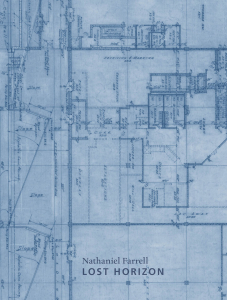Nathaniel Farrell Lost Horizon Ugly Duckling Presse $17

In her recent book, Prose Poetry and the City, Donna Stonecipher quotes Baudelaire on the prose poem, commenting that ‘out of my explorations of huge cities, out of the medley of their innumerable interrelations, that this haunting ideal was born.’ This ‘haunting ideal’ of Baudelaire’s was of a poetry that would be ‘supple enough and rugged enough to adapt itself to the lyrical impulses of the soul, the undulations of reverie, the jibes of conscience.’ If we place this beside Eliot’s ‘These fragments I have shored against my ruins,’ and a large dose of Olson-esque ‘open form’, you have some idea of the poetics which informs Nathaniel Farrell’s Lost Horizon. Then, of course, there is the title with its open reference to the idea of a Shangri-La, which sustains and revivifies but once lost leads to decay and death.
That is all rather a grand entrance to Farrell’s work, and which neatly skirts a lot of that with its remorselessly grounded imagery. The first thing to notice is that there are no subdivisions in the poem’s 83 pages. Each page is packed with deftly placed lines and images, which run the reader through from page 1 to page 83. In a note at the back, Farrell comments that the poem emerged from road travel around the US and also stays in such locations as the Hudson Valley, Mark Twain National Forest and the Mojave National Preserve. And the imagery of the poem seems clearly to have risen from the sights, sounds and imaginings that occur on such journeys. It begins:
The fountain full of coins the smell of pretzels, print, perfume
formaldehyde in fabrics
brass rails down stairwells rebar in the pillars
the underground parking structure – Roman Alphabet Arabic numerals –
Farrell forces the reader to take this all in slowly. And if the reader does that, and follows the imagery then there is much to admire. We might see that opening image as an image of good luck; particularly the element of luck needed at the start of a journey. This is not some grand evocation of the muse at the start of an epic poem, but something altogether less weighty but no less poignant. As are the smells evoked in the next phrase. These smells are contrasted with the smell that might emerge from the clothing claimed from the dry cleaners. Then that transition into the interior, with its neat evocation of city apartment dwelling, and the building’s own dependence on the support of the rebar, a steel reinforcement inside the concrete pillars, in its particular vocabulary. That followed by the slightly Dantesque descent into the underground car park with its designated places.
Farrell is equally adept at describing humans:
bobbing buttocks hair wet halfway up a strange girl’s back
twinkle of wet toes
beads on the eyelashes and elbows the trapezius muscle
clavicles under shore-ruffled moonlight, moonlight ruffled spring
Here there is an interesting combination of the erotic and the dispassionate. The focus shifts from the buttocks via the clinging hair and then that ‘twinkle’ of toes, to a small anatomy lesson. That first line has a clear sensuality, which moves into the more objective physicality of the wet body (with that coining of the cliché, ‘twinkle toes’) then on to the musculature.
Part of Farrell’s success in this text is the way in which he moves between things as things towards perceptions working around those things. Thus, Farrell tries to create a phenomenology which attempts to divest the things of interference from the perceiver. He does this with the use of phrases which are deliberately wrested from any grammatical context within a syntactic unit beyond themselves. He disrupts the discourse, if you like; we can note in the quotations I’ve given the complete absence of active verbs that might pin these phrases into processes. Then the Farrell makes those choices, selections which locate the phrases one against the other and then down the page. There is a narrative, but, in this part of the text at least, it is a narrative of things. Of course, that is a kind of contrivance; the poet pulls the strings. The poet controls those dispositions. And, to some extent, the reader buys into that. The reader has to suspend their own sense of narrative and throw in their lot with the writer. However, that might be said of all literature, that the reader is in the hands of the writer whether they are aware of the trajectory or not.
Towards the end of the text, there is much more sense of processes at work:
The seamless walls of grain elevators
power plant chimneys the legs of the rig –
concrete mix poured ceaseless into
the ceaselessly moving frame. My heart turns like
blown glass in tongs.
The door pushes open and
rings the shopkeeper’s bell.
We start here with the high structures of modern human making, from which substances which humans have made pours either up into the skies or down into our food processing, or along pipes into our energy needs. These things pour ‘into the ceaselessly moving frame’ of human demands. The reaction of the narrator is, perhaps, to realize just how appalling that ceaselessness really is; so appalling that the heart turns in the spectacular image of the blown glass in tongs. Then there is the deliberately bathetic image of the bell ringing at the shopkeeper’s door. Here, there is also consumerism if on a smaller, more intimate, more manageable scale, but consumerism nonetheless.
There are real rewards in this book, if you can put up with the somewhat relentless surface texture. Farrell’s demand that the reader slow down and absorb the sheer precision of the writing might possibly have worked better if there had been sections in the text. It is entirely possible that Farrell would have considered that possibility and rejected it.
By Ian Pople
